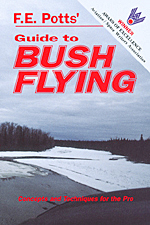"The ultimate guide to bush flying"
A review by Capt. Ken Armstrong
Canadian Owners and
Pilots Association
The company that publishes Janes All the World Aircraft directory asked me to submit an author's outline with the intent of publishing a book on bush flying techniques. About the same time, I became aware of F.E. Potts' Guide to Bush Flying - Concepts and Techniques for the Pro and requested a review copy from the author. After reading this tome I decided my book would have arrived on the market with too little, too late.
Potts is a 17,000 hour bush pilot with a flair for writing and 22 years experience flying in the harshest conditions Alaska could provide. The guide is chock full of suggestions, tips and advice that comes from hard-won experiences that could save you much anguish and pain during operations to the marginal strips that frequent the forests north of the 49th parallel.
Still, this book isn't for everyone. If you are a floatplane pilot, this book offers little information as it is aimed at wheel planes. Moreover, if you are timid or not prepared to hone your skills, the exacting flying required to accomplish Potts' techniques will elude you. In fact a major disclaimer warns pilots not to try these techniques without professional bush pilot training.
The purpose of the book was to educate and entertain without being an instruction manual. While the disclaimer covers the American fixation with liability, it should also jolt pilots to evaluate their skills, dedication to accuracy and their motivation for this most challenging aspect of flying.
The guide's 246 pages are supported with 46 photographs and Potts' writing style skips the superfluous fillers and sticks to the details. Can you learn from the content? After roughly 8,000 hours of Canadian bush flying I can easily say I learned a great deal from the book. Topics seldom discussed and rarely seen in aviation magazines are completely covered. If you are able to digest and absorb all of this information, you can rest assured you will be more knowledgeable than many professional bush pilots. Flying accurately and with discipline are skills you will then have to hone to be able to accomplish these advanced skills. (There is also plenty of imminently useful information for basic pilots as well, such as tie-down tips, preheating techniques, navigating, cold weather operations and survival techniques to name a few.)
At $34.95 (U.S.), the guide isn't cheap but then, what price do you put on your skills and the safety of your passengers? Even if you never plan to learn the techniques that will allow you to fly to the aircraft's maximum abilities, much of the information will be useful to casual, recreational pilots and knowledge of the procedures will make you a safer pilot.
Capt. Ken Armstrong is a COPA director and aviation consultant who lives in Victoria, British Columbia with his aviation-orientated wife, Linda. His writing and contributions to aviation safety were recognized by the Minister of Transport with the Canadian Aviation Safety Award. He has flown more than 13,000 hours in 250 aircraft types.
Review Copyright © 1998 by Canadian Flight Publishing Corp., all rights reserved. COPA, 1001-75 Albert St., Ottawa, ON, K1P 5E7, http://www.copanational.org. (303) 397-7600. Used by permission.
[Footnotes by F. E. Potts]
